Introduction and Evidence for Early Mobility: A Protocol To Get Patients Out of Bed Faster: Slide Presentation
AHRQ Safety Program for Mechanically Ventilated Patients
Slide 1: AHRQ Safety Program for Mechanically Ventilated Patients
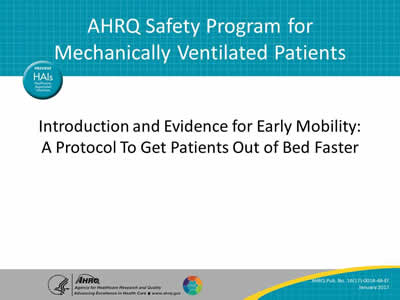
Introduction and Evidence for Early Mobility: A Protocol To Get Patients Out of Bed Faster
Slide 2: Learning Objectives
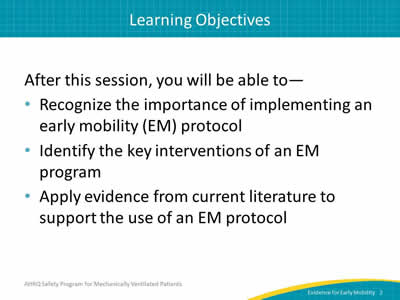
After this session, you will be able to—
- Recognize the importance of implementing an early mobility (EM) protocol.
- Identify the key interventions of an EM program.
- Apply evidence from current literature to support the use of an EM protocol.
Slide 3: Importance of Early Mobility
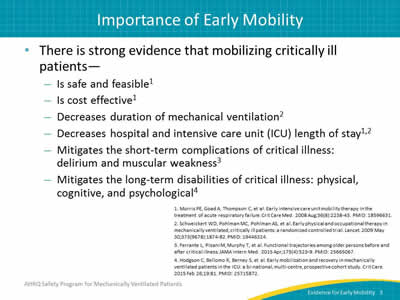
- There is strong evidence that mobilizing critically ill patients—
- Is safe and feasible.1
- Is cost effective.1
- Decreases duration of mechanical ventilation.2
- Decreases hospital and intensive care unit (ICU) length of stay.1,2
- Mitigates the short-term complications of critical illness: delirium and muscular weakness.3
- Mitigates the long-term disabilities of critical illness: physical, cognitive, and psychological.4
1. Morris PE, Goad A, Thompson C, et al. Early intensive care unit mobility therapy in the treatment of acute respiratory failure. Crit Care Med 2008 Aug;36(8):2238-43. PMID: 18596631.
2. Schweickert WD, Pohlman MC, Pohlman AS, et al. Early physical and occupational therapy in mechanically ventilated, critically ill patients: a randomized controlled trial. Lancet 2009 May 30;373(9678):1874-82. PMID: 19446324.
3. Ferrante L, Pisani M, Murphy T, et al. Functional trajectories among older persons before and after critical illness. JAMA Intern Med 2015 Apr;175(4):523-9. PMID: 25665067.
4. Hodgson C, Bellomo R, Berney S, et al. Early mobilization and recovery in mechanically ventilated patients in the ICU: a bi-national, multi-centre, prospective cohort study. Crit Care 2015 Feb 26;19:81. PMID: 25715872.
Slide 4: Daily EM: Summary of Key Interventions
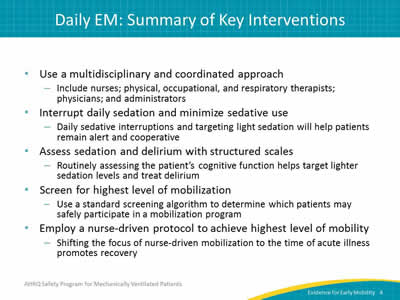
- Use a multidisciplinary and coordinated approach:
- Include nurses; physical, occupational, and respiratory therapists; physicians; and administrators.
- Interrupt daily sedation and minimize sedative use:
- Daily sedative interruptions and targeting light sedation will help patients remain alert and cooperative.
- Assess sedation and delirium with structured scales:
- Routinely assessing the patient’s cognitive function helps target lighter sedation levels and treat delirium.
- Screen for highest level of mobilization:
- Use a standard screening algorithm to determine which patients may safely participate in a mobilization program.
- Employ a nurse-driven protocol to achieve highest level of mobility:
- Shifting the focus of nurse-driven mobilization to the time of acute illness promotes recovery.
Slide 5: Evidence From Two Studies
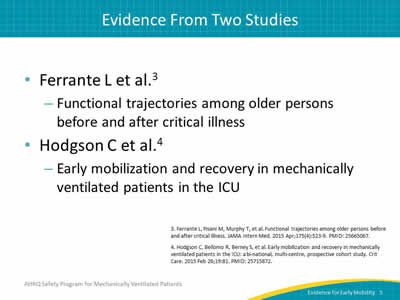
- Ferrante L et al.3
- Functional trajectories among older persons before and after critical illness.
- Hodgson C et al.4
- Early mobilization and recovery in mechanically ventilated patients in the ICU.
3. Ferrante L, Pisani M, Murphy T, et al. Functional trajectories among older persons before and after critical illness. JAMA Intern Med 2015 Apr;175(4):523-9. PMID: 25665067.
4. Hodgson C, Bellomo R, Berney S, et al. Early mobilization and recovery in mechanically ventilated patients in the ICU: a bi-national, multi-centre, prospective cohort study. Crit Care 2015 Feb 26;19:81. PMID: 25715872.
Slide 6: Functional Trajectories Among Older Persons Before and After critical Illness3
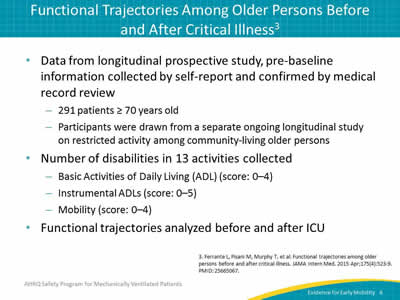
- Data from longitudinal prospective study, pre-baseline information collected by self-report and confirmed by medical record review:
- 291 patients ≥ 70 years old.
- Participants were drawn from a separate ongoing longitudinal study on restricted activity among community-living older persons.
- Number of disabilities in 13 activities collected:
- Basic Activities of Daily Living (ADL) (score: 0–4).
- Instrumental ADLs (score: 0–5).
- Mobility (score: 0–4).
- Functional trajectories analyzed before and after ICU.
3. Ferrante L, Pisani M, Murphy T, et al. Functional trajectories among older persons before and after critical illness. JAMA Intern Med 2015 Apr;175(4):523-9. PMID: 25665067.
Slide 7: Functional Trajectories Pre and Post ICU3
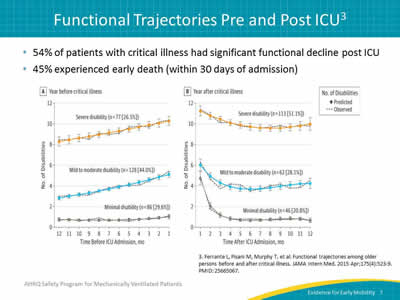
- 54% of patients with critical illness had significant functional decline post ICU.
- 45% experienced early death (within 30 days of admission).
Image: Graph of functional trajectories of older patients before and after ICU.
3. Ferrante L, Pisani M, Murphy T, et al. Functional trajectories among older persons before and after critical illness. JAMA Intern Med 2015 Apr;175(4):523-9. PMID: 25665067.
Slide 8: Functional Trajectories Pre and Post ICU3
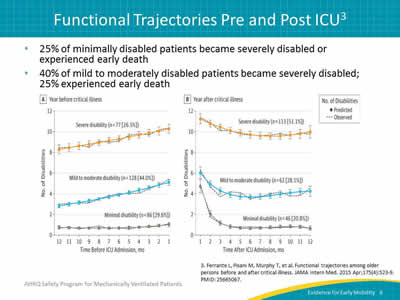
- 25% of minimally disabled patients became severely disabled or experienced early death.
- 40% of mild to moderately disabled patients became severely disabled; 25% experienced early death.
Image: Graph of functional trajectories of older patients before and after ICU.
3. Ferrante L, Pisani M, Murphy T, et al. Functional trajectories among older persons before and after critical illness. JAMA Intern Med 2015 Apr;175(4):523-9. PMID: 25665067.
Slide 9: Mortality Associated With Worsening Pre-ICU Functional Trajectory3
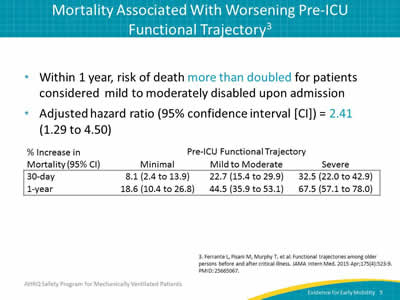
- Within 1 year, risk of death more than doubled for patients considered mild to moderately disabled upon admission.
- Adjusted Hazard Ratio (95% CI) = 2.41 (1.29 to 4.50).
Image: Table showing mortality associated with worsening pre-ICU functional trajectory.
3. Ferrante L, Pisani M, Murphy T, et al. Functional trajectories among older persons before and after critical illness. JAMA Intern Med 2015 Apr;175(4):523-9. PMID: 25665067.
Slide 10: Mortality Associated With Worsening Pre-ICU Functional Trajectory3
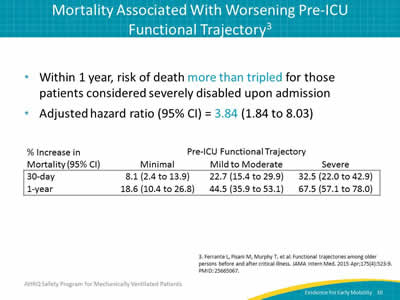
- Within 1 year, risk of death more than tripled for those patients considered severely disabled upon admission.
- Adjusted Hazard Ratio (95% CI) = 3.84 (1.84 to 8.03).
Image: Table showing mortality associated with worsening pre-ICU functional trajectory.
3. Ferrante L, Pisani M, Murphy T, et al. Functional trajectories among older persons before and after critical illness. JAMA Intern Med 2015 Apr;175(4):523-9. PMID: 25665067.
Slide 11: Summary3
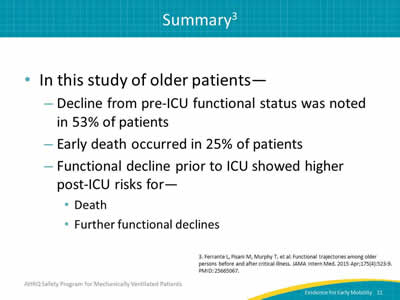
- In this study of older patients—
- Decline from pre-ICU functional status was noted in 53% of patients.
- Early death occurred in 25% of patients.
- Functional decline prior to ICU showed higher post-ICU risks for—
- Death.
- Further functional declines.
3. Ferrante L, Pisani M, Murphy T, et al. Functional trajectories among older persons before and after critical illness. JAMA Intern Med 2015 Apr;175(4):523-9. PMID: 25665067.
Slide 12: Early Mobilization and Recovery of Mechanically Ventilated Patients in the ICU4
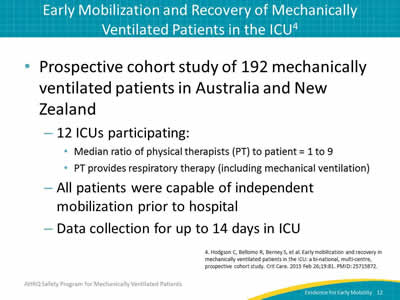
- Prospective cohort study of 192 mechanically ventilated patients in Australia and New Zealand:
- 12 ICUs participating:
- Median ratio of physical therapists (PT) to patient = 1 to 9.
- PT provides respiratory therapy (including mechanical ventilation).
- All patients were capable of independent mobilization prior to hospital.
- Data collection for up to 14 days in ICU.
- 12 ICUs participating:
4. Hodgson C, Bellomo R, Berney S, et al. Early mobilization and recovery in mechanically ventilated patients in the ICU: a bi-national, multi-centre, prospective cohort study. Crit Care 2015 Feb 26;19:81. PMID: 25715872.
Slide 13: Objectives4
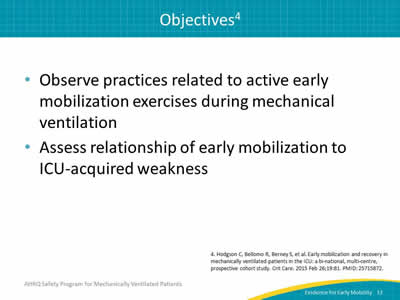
- Observe practices related to active early mobilization exercises during mechanical ventilation.
- Assess relationship of early mobilization to ICU-acquired weakness.
4. Hodgson C, Bellomo R, Berney S, et al. Early mobilization and recovery in mechanically ventilated patients in the ICU: a bi-national, multi-centre, prospective cohort study. Crit Care 2015 Feb 26;19:81. PMID: 25715872.
Slide 14: Findings4
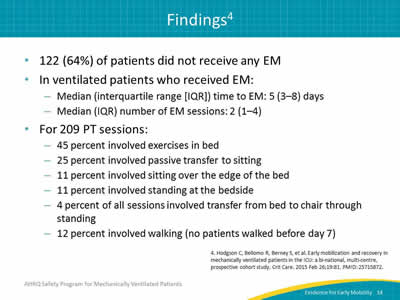
- 122 (64%) of patients did not receive any EM.
- In ventilated patients who received EM:
- Median (interquartile range [IQR]) time to EM: 5 (3-8) days.
- Median (IQR) number of EM sessions: 2 (1-4).
- For 209 PT sessions:
- 45 percent involved exercises in bed.
- 25 percent involved passive transfer to sitting.
- 11 percent involved sitting over the edge of the bed.
- 11 percent involved standing at the bedside.
- 4 percent of all sessions involved transfer from bed to chair through standing.
- 12 percent involved walking (no patients walked before day 7).
4. Hodgson C, Bellomo R, Berney S, et al. Early mobilization and recovery in mechanically ventilated patients in the ICU: a bi-national, multi-centre, prospective cohort study. Crit Care 2015 Feb 26;19:81. PMID: 25715872.
Slide 15: PT Reported Barriers to Early Mobilization4
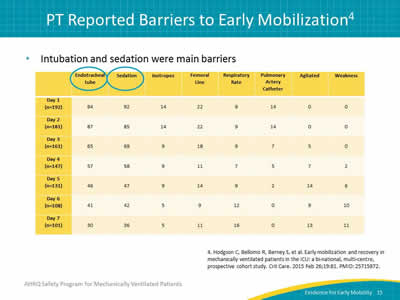
- Intubation and sedation were main barriers.
Image: Table showing the main barriers for early mobilization.
4. Hodgson C, Bellomo R, Berney S, et al. Early mobilization and recovery in mechanically ventilated patients in the ICU: a bi-national, multi-centre, prospective cohort study. Crit Care 2015 Feb 26;19:81. PMID: 25715872.
Slide 16: Time to Activity4
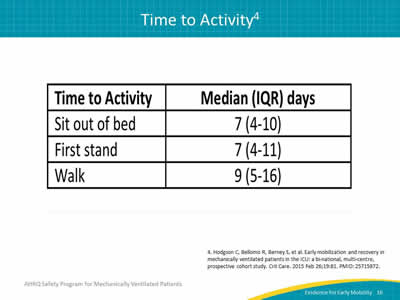
Image: Table showing the time to activity for patients in the ICU.
4. Hodgson C, Bellomo R, Berney S, et al. Early mobilization and recovery in mechanically ventilated patients in the ICU: a bi-national, multi-centre, prospective cohort study. Crit Care 2015 Feb 26;19:81. PMID: 25715872.
Slide 17: Other Outcomes4
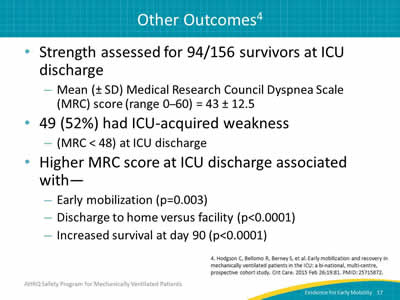
- Strength assessed for 94/156 survivors at ICU discharge:
- Mean (± SD) Medical Research Council Dyspnea Scale (MRC) score (range 0-60) = 43 ± 12.5.
- 49 (52%) had ICU-acquired weakness:
- (MRC < 48) at ICU discharge.
- Higher MRC score at ICU discharge associated with—
- Early mobilization (p=0.003).
- Discharge to home versus facility (p<0.0001).
- Increased survival at day 90 (p<0.0001).
4. Hodgson C, Bellomo R, Berney S, et al. Early mobilization and recovery in mechanically ventilated patients in the ICU: a bi-national, multi-centre, prospective cohort study. Crit Care 2015 Feb 26;19:81. PMID: 25715872.
Slide 18: Summary4
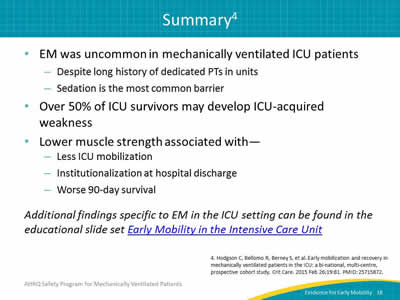
- EM was uncommon in mechanically ventilated ICU patients:
- Despite long history of dedicated PTs in units.
- Sedation is the most common barrier.
- Over 50% of ICU survivors may develop ICU-acquired weakness.
- Lower muscle strength associated with—
- Less ICU mobilization.
- Institutionalization at hospital discharge.
- Worse 90-day survival.
Additional findings specific to EM in the ICU setting can be found in the educational slide set Early Mobility in the Intensive Care Unit.
4. Hodgson C, Bellomo R, Berney S, et al. Early mobilization and recovery in mechanically ventilated patients in the ICU: a bi-national, multi-centre, prospective cohort study. Crit Care 2015 Feb 26;19:81. PMID: 25715872.
Slide 19: Evidence of Early Mobility—Recap
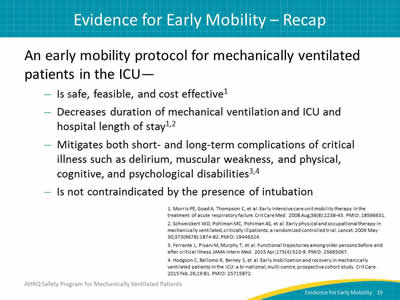
An early mobility protocol for mechanically ventilated patients in the ICU…
- Is safe, feasible, and cost effective.1
- Decreases duration of mechanical ventilation and ICU and hospital length of stay.1,2
- Mitigates both short- and long-term complications of critical illness such as delirium, muscular weakness, and physical, cognitive, and psychological disabilities.3,4
- Is not contraindicated by the presence of intubation.
1. Morris PE, Goad A, Thompson C, et al. Early intensive care unit mobility therapy in the treatment of acute respiratory failure. Crit Care Med 2008 Aug;36(8):2238-43. PMID: 18596631.
2. Schweickert WD, Pohlman MC, Pohlman AS, et al. Early physical and occupational therapy in mechanically ventilated, critically ill patients: a randomized controlled trial. Lancet 2009 May 30;373(9678):1874-82. PMID: 19446324.
3. Ferrante L, Pisani M, Murphy T, et al. Functional trajectories among older persons before and after critical illness. JAMA Intern Med 2015 Apr;175(4):523-9. PMID: 25665067.
4. Hodgson C, Bellomo R, Berney S, et al. Early mobilization and recovery in mechanically ventilated patients in the ICU: a bi-national, multi-centre, prospective cohort study. Crit Care 2015 Feb 26;19:81. PMID: 25715872.
Slide 20: Questions?
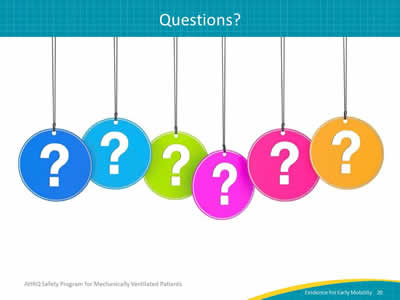
Image: Multicolored hanging question marks on tags.
Slide 21: References
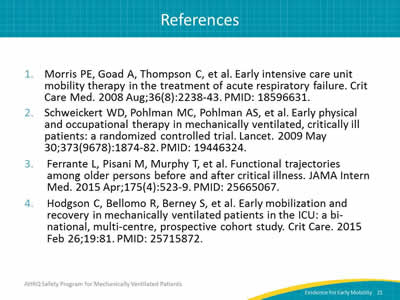
1. Morris PE, Goad A, Thompson C, et al. Early intensive care unit mobility therapy in the treatment of acute respiratory failure. Crit Care Med 2008 Aug;36(8):2238-43. PMID: 18596631.
2. Schweickert WD, Pohlman MC, Pohlman AS, et al. Early physical and occupational therapy in mechanically ventilated, critically ill patients: a randomized controlled trial. Lancet 2009 May 30;373(9678):1874-82. PMID: 19446324.
3. Ferrante L, Pisani M, Murphy T, et al. Functional trajectories among older persons before and after critical illness. JAMA Intern Med 2015 Apr;175(4):523-9. PMID: 25665067.
4. Hodgson C, Bellomo R, Berney S, et al. Early mobilization and recovery in mechanically ventilated patients in the ICU: a bi-national, multi-centre, prospective cohort study. Crit Care 2015 Feb 26;19:81. PMID: 25715872.



